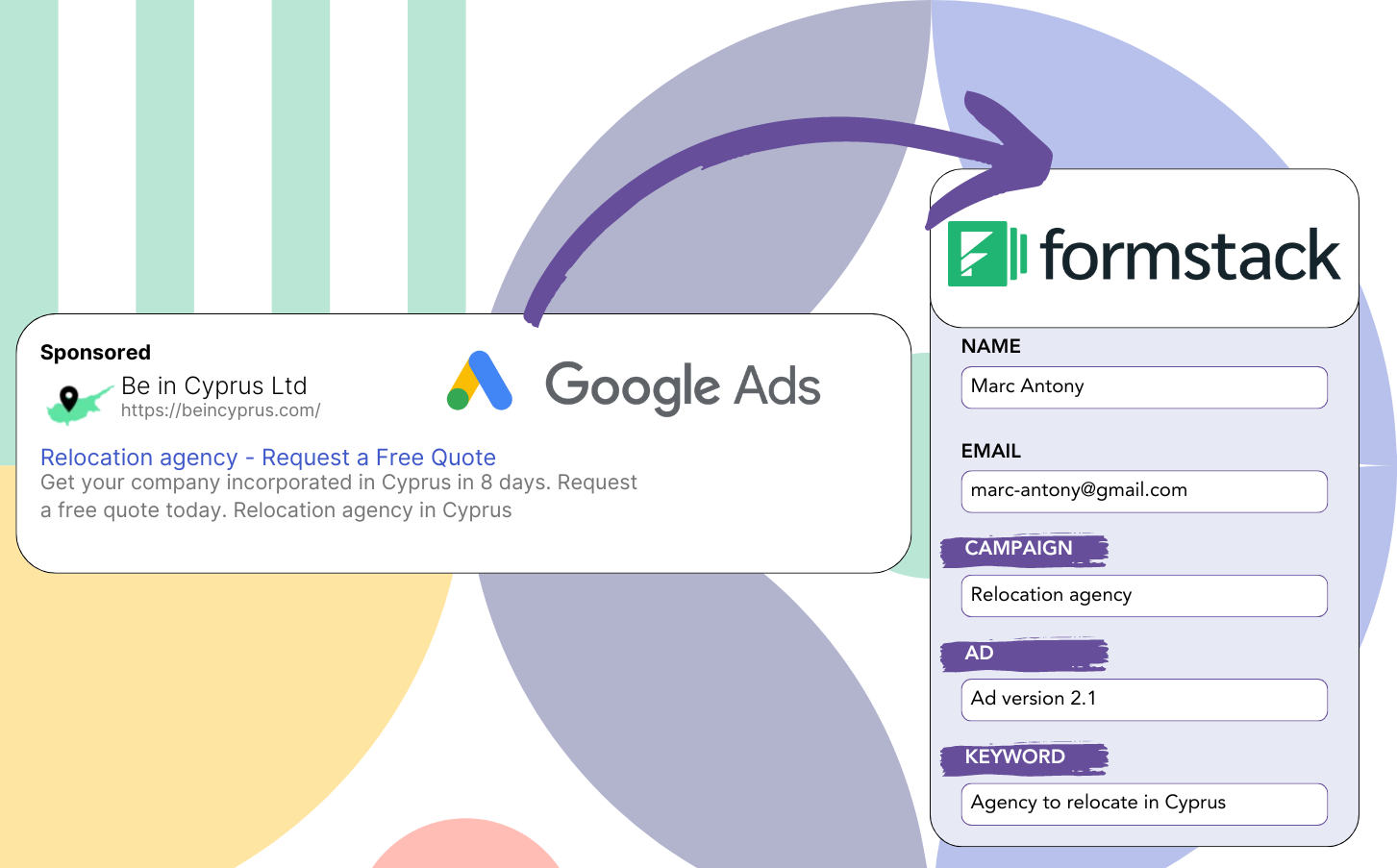You’re generating leads with Google Ads, but are you sure which campaigns are contributing?
This is a recognized issue. Google Ads shows lead numbers by campaign, ad, or keyword, but does not detail individual leads.
Consequently, it remains unclear which campaign, ad, or keyword generated the leads that became customers.
LeadSources eliminates this problem.
LeadSources helps you monitor your Google Ads data (campaign, ad, keyword, etc.) on a per-lead basis.
This enables you to save Google Ads data (campaign, ad, keyword, etc.) for each lead in Formstack.
You can then develop reports like “Keywords that generated the most leads” and determine which keywords to advance or discard.
Let’s proceed!
Capture Google Ads lead data in Formstack in 4 steps
Step 1: Add Leadsources in the head tag of your website
Sign up to Leadsources.io, and benefit from our 14-day free trial.
Add the LeadSources code into your website’s head tag. No coding expertise is required.
Simply follow this easy step-by-step guide.
Step 2: Add the UTM parameters to your Google Ads campaigns
Add the UTM parameters you wish to see in all your Google Ads campaigns.
Examples of UTM parameters for your ad include:
- UTM_source
- UTM_campaign
- UTM_term
- UTM_content
LeadSources tracks additional data not included in UTM parameters, such as the channel, landing page, and subfolder, to give you a complete lead-level overview.
Step 3: Add the hidden fields in Formstack
As visitors enter their information on your Forsmtack (name, email, etc.), LeadSources fills the hidden fields with Google Ads data (campaign, ad, keyword, landing page, etc.).
For adding hidden fields in Formstack, refer to this guide.
LeadSources will ensure the Google Ads data is stored directly in your Formstack.
Step 4: Capture the Google Ads data in Formstack
When a visitor clicks your Google Ads ad and lands on your website, LeadSources captures the relevant Google Ads data (campaign, ad, keyword, landing page, etc.).
LeadSources automatically updates the hidden fields of your Formstack with Google Ads data.
After the form submission, the Google Ads data and the responses are transferred to the submissions page in Formstack.
How does Leadsources work?
Adding the LeadSources code to your website’s head tag allows it to collect Google Ads data (UTM parameters and referrer) with each visit to your site.
It inserts the Google Ads data into the hidden fields of your Formstack.
If a visitor arrives at your site without UTM parameters, LeadSources will still record data through the referrer:
- Channel
- Source
- Campaign
- Landing page
- Landing page subfolder
This approach ensures you can monitor significant lead source information even in the absence of UTM parameters, including:
- On Google Search
- On your Instagram bio link
- On your social media posts
- Etc.
Lead data is usually tracked by most tools only if UTM parameters are used (mainly for paid and referral channels) – creating a problem!
LeadSources ensures lead data is captured for all channels, even when UTM parameters are not available:
- Organic Search
- Paid Search
- Organic Social
- Paid Social
- Referral
- Affiliate
- Display Advertising
- Direct Traffic
This enables you to bring together and track all lead source data in one central place.
Pro tip:
Track Google Ads data in all the popular online form builders, including Cognito Forms, Gravity Forms, Jotform, Typeform, WPForms, and more. Learn how to add Google Ads UTM parameters in any form builder.
How to run performance reports
Your stored Google Ads data in Formstack that enables you to produce performance reports such as:
- Leads per campaign
- Leads per ad
- Leads per keyword
- Etc.
This aids in making well-considered decisions about your Google Ads outlay.
Let’s consider the various reports you are able to create.
Lead performance reports
You can produce reports showing the count of leads generated by:
- Channel
- Campaign
- Ad
- Keyword
- Landing page
- Landing page subfolder
Example #1
By exporting data from campaigns on different channels (SEO, PPC, email, etc.), you can produce a report called “Leads by Channel.”
Example #2
After establishing which channel produces the most leads (e.g., Google Ads), you can refine your analysis by selecting this channel to view the lead count for each individual ad campaign.
Example #3
Once you identify the top campaign for lead generation, you can check which specific keywords are responsible for these leads.
Sales performance report
Discovering which ads and keywords yield the most leads is important, but do they also increase your revenue?
By directing your Formstack submissions to a CRM, you can develop in-depth sales reports.
Example:
| Channels | Search Paid | Social Paid |
| Leads | 50 | 75 |
| Sales | 5 | 6 |
| Average order value | $150 | $100 |
| Revenue | $750 | $600 |
After launching ads on both Google and Facebook, you identified that Social Paid ads delivered more leads than Search Paid ads.
Over several weeks, analyzing lead conversion data shows that the Search Paid channel produced higher revenue with fewer leads than the Social Paid channel. This suggests increasing the budget for Search Paid campaigns.
LeadSources tracks the source of each lead in Formstack, whether they come from ads, organic search, social, email, etc. and syncs that data with each submission. See the full breakdown on the lead source in Formstack page.
